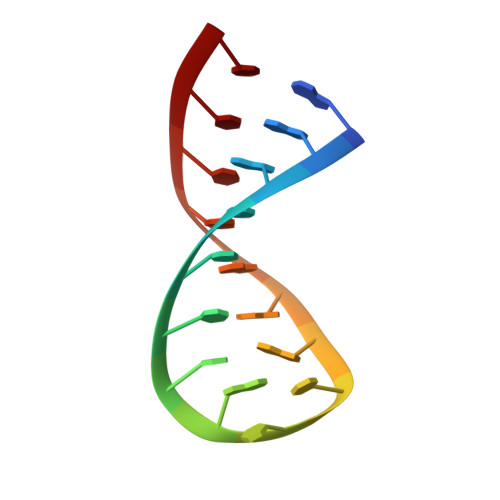Solution Nuclear Magnetic Resonance Analyses of the Anticodon Arms of Proteinogenic and Nonproteinogenic tRNA(Gly).
Chang, A.T., Nikonowicz, E.P.(2012) Biochemistry 51: 3662-3674
- PubMed: 22468768
- DOI: https://doi.org/10.1021/bi201900j
- Primary Citation of Related Structures:
2LBJ, 2LBK, 2LBL - PubMed Abstract:
Although the fate of most tRNA molecules in the cell is aminoacylation and delivery to the ribosome, some tRNAs are destined to fulfill other functional roles. In addition to their central role in translation, tRNA molecules participate in processes such as regulation of gene expression, bacterial cell wall biosynthesis, viral replication, antibiotic biosynthesis, and suppression of alternative splicing. In bacteria, glycyl-tRNA molecules with anticodon sequences GCC and UCC exhibit multiple extratranslational functions, including transcriptional regulation and cell wall biosynthesis. We have determined the high-resolution structures of three glycyl-tRNA anticodon arms with anticodon sequences GCC and UCC. Two of the tRNA molecules are proteinogenic (tRNA(Gly,GCC) and tRNA(Gly,UCC)), and the third is nonproteinogenic (np-tRNA(Gly,UCC)) and participates in cell wall biosynthesis. The UV-monitored thermal melting curves show that the anticodon arm of tRNA(Gly,UCC) with a loop-closing C-A(+) base pair melts at a temperature 10 °C lower than those of tRNA(Gly,GCC) and np-tRNA(Gly,UCC). U-A and C-G pairs close the loops of the latter two molecules and enhance stem stability. Mg(2+) stabilizes the tRNA(Gly,UCC) anticodon arm and reduces the T(m) differential. The structures of the three tRNA(Gly) anticodon arms exhibit small differences among one another, but none of them form the classical U-turn motif. The anticodon loop of tRNA(Gly,GCC) becomes more dynamic and disordered in the presence of multivalent cations, whereas metal ion coordination in the anticodon loops of tRNA(Gly,UCC) and np-tRNA(Gly,UCC) establishes conformational homogeneity. The conformational similarity of the molecules is greater than their functional differences might suggest. Because aminoacylation of full-length tRNA molecules is accomplished by one tRNA synthetase, the similar structural context of the loop may facilitate efficient recognition of each of the anticodon sequences.
Organizational Affiliation:
Department of Biochemistry and Cell Biology, Rice University, Houston, Texas 77251-1892, United States.














